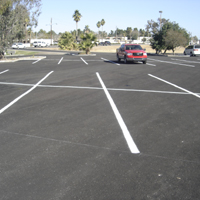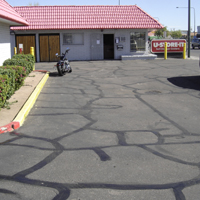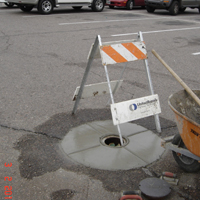Preventative Maintenance
Slurry Sealing

A worn or deteriorated surface that is still structurally sound may desire a slurry seal. This is ¾" of cold mixed asphalt overlay placed on the existing surface. Slurry sealing provides a brand new surface that extends the life of your asphalt and is aesthetically pleasing. It is recommended that severely cracked or failed areas be replaced and or crackfilled before applying the slurry seal. If these areas and cracks are not corrected, the cracking may become visible through the slurried surface. The large benefit of a slurry seal is that it fills minor voids and unevenness in the existing pavement while providing a new smooth surface.
The slurry truck mixes aggregate, binder, and water on site; the exact proportions are specified for each project. The mixed slurry is applied to the pavement through a spreader at the back of the truck. American Asphalt uses squeeges to apply the slurry seal in areas in which the truck cannot fit. The new overlay is finally compacted with a steel wheel roller to achieve designed strength and smoothness.
Fresh slurry seal loses surface aggregate in a process called "raveling". Even though new traffic may cause slight deformations on the slurry surface, it will compact back down during its two month curing phase. Slurry sealing is becoming a very popular cost-efficient technique in restoring old pavements. One day after the slurry seal is applied, American Asphalt returns and re-stripes the regions exactly the way they existed. Directional arrows, no parking or fire zones, and crosswalks can be added to improve traffic flow and pedestrian safety.
Asphalt Overlays
It can be very costly removing and replacing large areas of failed asphalt, such as a shopping center. The Petro-Mat® system is an alternative surface that provides a cost-effective and time-saving solution. The Petro-Mat® Overlay is a fabric application with a 1 ½" of asphalt over the existing surface. This high strength fabric acts like rebar in concrete; it provides shear and lateral strength over existing cracks and voids in the pavement, also creating an impermeable layer between the old and new surfaces that moisture cannot penetrate.
This operation starts with sweeping and cleaning the existing surface. Cracks ¼" or wider are filled with cracksealer and holes or voids are filled with hotmix. Liquid asphalt cement at 290F is then applied at a specific rate. The Petro-Mat® is then put down by a mechanical applicator and the new mat is rolled to smooth out air pockets and wrinkles. Standard paving operations follow the fabric overlay using a minimum of 1 ½" of new asphalt. The new hotmix provides more heat and pressure to bond the systems together. The asphalt overlay is finally compacted with a steel wheel roller. The true benefit of using the Petro-Mat® system is that the new surface uses the existing sub-base and asphalt surface as its base. Proper installation of the Petro-Mat® system and asphalt overlay is critical to ensure successful long-term performance.
One day after the overlay, American Asphalt returns and re-stripes these regions exactly the way they existed. Directional arrows, no parking or fire zones, and crosswalks can be added to improve traffic flow and pedestrian safety.
Sealcoating
 A worn or deteriorated surface that is still structurally sound may desire a slurry seal. This is ¾" of cold mixed asphalt overlay placed on the existing surface. Slurry sealing provides a brand new surface that extends the life of your asphalt and is aesthetically pleasing. It is recommended that severely cracked or failed areas be replaced and or crackfilled before applying the slurry seal. If these areas and cracks are not corrected, the cracking may become visible through the slurried surface. The large benefit of a slurry seal is that it fills minor voids and unevenness in the existing pavement while providing a new smooth surface.
A worn or deteriorated surface that is still structurally sound may desire a slurry seal. This is ¾" of cold mixed asphalt overlay placed on the existing surface. Slurry sealing provides a brand new surface that extends the life of your asphalt and is aesthetically pleasing. It is recommended that severely cracked or failed areas be replaced and or crackfilled before applying the slurry seal. If these areas and cracks are not corrected, the cracking may become visible through the slurried surface. The large benefit of a slurry seal is that it fills minor voids and unevenness in the existing pavement while providing a new smooth surface.
The slurry truck mixes aggregate, binder, and water on site; the exact proportions are specified for each project. The mixed slurry is applied to the pavement through a spreader at the back of the truck. American Asphalt uses squeeges to apply the slurry seal in areas in which the truck cannot fit. The new overlay is finally compacted with a steel wheel roller to achieve designed strength and smoothness.
Fresh slurry seal loses surface aggregate in a process called "raveling". Even though new traffic may cause slight deformations on the slurry surface, it will compact back down during its two month curing phase. Slurry sealing is becoming a very popular cost-efficient technique in restoring old pavements. One day after the slurry seal is applied, American Asphalt returns and re-stripes the regions exactly the way they existed. Directional arrows, no parking or fire zones, and crosswalks can be added to improve traffic flow and pedestrian safety.
Striping and Marking
American Asphalt has striped everything from airports to parking lots. Professional striping reduces chance of accidents, dictates directional flow, and improves pedestrian safety. Speedbumps, directional arrows, stop bars, crosswalks and handicap stalls are only a few of our talents. We also provide reflective paint for driving lanes and markings.
Crackfilling
 Even though asphalt is flexible pavement, it is a still susceptible to cracking and crackfilling is one of the most important preventative maintenance procedures. General cracking in the asphalt pavement does not mean that the pavement or sub-base has failed. However, unsealed cracks leave a gateway for water and moisture to seep into the sub-grade and cause pumping, expanding and contracting of the soil due to changing moisture content.
Even though asphalt is flexible pavement, it is a still susceptible to cracking and crackfilling is one of the most important preventative maintenance procedures. General cracking in the asphalt pavement does not mean that the pavement or sub-base has failed. However, unsealed cracks leave a gateway for water and moisture to seep into the sub-grade and cause pumping, expanding and contracting of the soil due to changing moisture content.
Cracks ¼" or wider are initially cleaned free of debris using compressed air. The cracks are then filled with a hot rubberized cracksealer. Cracksealer is applied at over 300F, which allows it to ooze down and fill the voids completely.
Cracksealing is a cost effective maintenance procedure that acts as a barrier to moisture and bonds cracked pavement together. American Asphalt also recommends that a sealcoat be applied with the cracksealing to fill all of the minor voids in the pavement's surface.
Concrete Work
Valley Gutter
 A valley gutter is a section of concrete that is used to channel water to a drainage point. Poor drainage and/or ponding of water can lead to accelerated pavement deterioration. Valley gutters help with rain water as well as irrigation runoff.
A valley gutter is a section of concrete that is used to channel water to a drainage point. Poor drainage and/or ponding of water can lead to accelerated pavement deterioration. Valley gutters help with rain water as well as irrigation runoff.
Dumpster Approach and Mat
A concrete slab is recommended for the approach as well as a mat for the dumpster to rest on. Typical parking lot asphalt is not designed for and may not withstand the stress and load of the trucks. Concrete is a stronger material and can sustain a much higher load capacity.
Curbs
The most common curbs are used to separate pavement or parking lot areas from landscaped areas and sidewalks. Just like any other parking lot product, curbs sometimes do get bumped or naturally deteriorate. American Asphalt repairs existing curbs and places new curbs with respect to specification detail.
Ramp
Asphalt or concrete, depending on the purpose, ramps are important for disabilities, code, deliverables and receivables.
Sidewalks
Sidewalks are important for pedestrian safety and marking clear paths to and from any given areas. American Asphalt repairs and installs any sidewalk that serves pedestrians and/or vehicles.
Utility Aprons
It may be recommended or required that manhole, water, and sewer covers have a concrete apron. This rigid pavement provides a secure support around the manhole or water valve cover. This also prevents flexible pavement from overlapping and creeping over the covers.
Entrance Ways
The entrance of parking lots are exposed to a high volume of traffic. This is a frequent area where asphalt failing occurs. A concrete entrance way provides strength against the lateral shear of vehicles turning in and out of the way.
Wheel Stops/ Parking Blocks
Wheel Stops/ Parking Blocks are designed to protect vehicles against hitting curbs and or other vehicles. American Asphalt replaces a variety of old and cracked wheel stops as well as installs for new construction.


